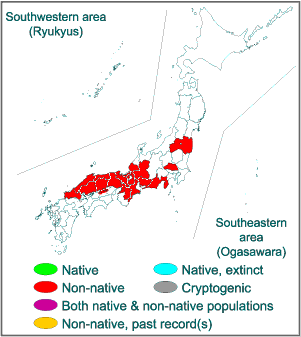
 Japanese |
English
Japanese |
English- Invasive Species of Japan >
- Mammals >
- Myocastor coypus
| Invasion information | ||
| Range in Japan | Established in Fukushima, Saitama, Fukui, Gifu, Shizuoka, Aichi, Mie, Nara, Shiga, Kyoto, Osaka, Hyogo, Okayama, Tottori, Hiroshima, Shimane, Yamaguchi and Kagawa Prefs. There are several records of temporary observation or past establishment in several other regions (some of those might be misidentification of musk rat or mink). |

|
| Origin | Import of 150 nutrias in 1939 was from France. | |
| Date | The first introduction was late Maiji Era (around 1900s). In 1939, 150 nutrias were imported and farmed for military and consumer use in Kanto District to western Japan. Mass release and escape may occur just after W.W.II and after fur vogue in 1950s. | |
| Route | Deliberate: Release and escape of cultivated nutria for fur production in the W.W.II period. This species have also been introduced in other countries for fur production, because this species has good fur as an adaptation to semiaquatic habitat. In other countries, this species is sometimes released for control of aquatic and waterfront weeds or as a sports hunting animal. | |
| Impact | Actually: Damage on aquatic plants. Destruction of bank, rice field walk, and water reservior by burrowing. Damage on agricultre. Native organism(s) affected: Aquatic plants, crops (various crops such as rice, fruits, vegetables). | |
| Regulation in Japan | Import, transport and keeping are prohibited in Japan by the Invasive Alien Species Act. | |
| Introduced range in other countries | Azerbaijan, Georgia, Israel, Jordan, Kazakhstan, Tajikistan, Turkey, Turkmenistan, wide area in Europe, Kenya, wide are in USA, Canada, northern Mexico, etc. | |
| Reference | Notes |
|
100 of the World's Worst Invasive Alien Species, 100 of the Japan's Worst Invasive Alien Species |